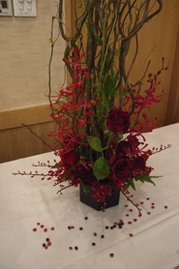月曜日Getsuyoubi Monday.
火曜日 Kayoubi Tuesday.
水曜日Suiyoubi Wednesday.
木曜日 Mokuyoubi Thursay.
金曜日Kinyoubi Friday.
土曜日Doyoubi Saturday.
日曜日Nichiyoubi Sunday.
The key to understanding the names of the days of the week lies in that obscure second character . Pronounced yao4 in Mandarin Chinese, means 'sunlight' or 'luminary; shining body'. The sun, the moon, and the five planets were called the 'seven luminaries' ( qi1 yao4) by the ancient Chinese, much as the ancient Greeks and Romans referred to them as the seven planets. It is from the 'seven luminaries' that the Japanese days of the week are derived.
The first two days of the week are named after the sun and the moon, which represent the male principle ( yang2) and the female principle ( yin1) respectively.
To understand the remaining five we must look at the ancient Chinese theory of the 'Five Elements' (wu3 xing2). The Five Elements started out as a primitive system for explaining the universe but gradually developed to become an all-embracing cosmological system. Each element was equated to (among others) a direction, a colour, a season, a time of day, a planet, and a musical note in the pentatonic scale.
Fire ( huo3) was equated to south, red, summer, midday, the planet Mars, and note 5 in numbered musical notation.
Water ( shui3) was equated to north, black, winter, midnight, the planet Mercury, and note 6 in numbered musical notation.
Wood ( mu4) was equated to east, green, spring, dawn, the planet Jupiter, and note 3 in numbered musical notation.
Gold or Metal ( jin1) was equated to west, white, autumn, dusk, the planet Venus, and note 2 in numbered musical notation.
Earth ( tu3), was equated to the centre, yellow, 18 days at the end of each season, the planet Saturn, and note 1 in numbered musical notation.
skip to main |
skip to sidebar

Appreciate the small things in life. It's not difficult to be happy.

Love is a puzzle.

Love the elegance.
A smile a day chases the nasty thoughts away :)
Me.
私の名前はジャスミンコーです。
My name is Jasmine Koh.
My name is Jasmine Koh.
Smile Always!

Appreciate the small things in life. It's not difficult to be happy.
日本の料理。美味しい!
www.flickr.com
This is a Flickr badge showing photos in a set called Japanese food. Make your own badge here.
A mile A minute.
愛。

Love is a puzzle.
Labels
- ASKJR (23)
- Japanese Food (14)
- Merger (19)
- Mountaineers (5)
- Swiss Cottage (15)
- Tweets (22)
See the beauty.

Love the elegance.

